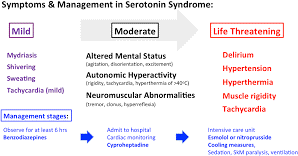A nurse is caring for a client at a clinic.
Complete the following sentence by using the lists of options. The client is at risk for developing
The Correct Answer is {"dropdown-group-1":"C","dropdown-group-2":"C"}
Rationale:
Serotonin syndrome is a serious drug reaction that results from having too much serotonin in the body. Serotonin is a chemical that plays a role in mood, sleep, appetite and other functions. Some medications, especially antidepressants, can increase serotonin levels and cause serotonin syndrome. The client is taking paroxetine, which is a type of antidepressant called a selective serotonin reuptake inhibitor (SSRI). SSRIs work by blocking the reabsorption of serotonin in the brain, making more serotonin available.
Paroxetine can cause serotonin syndrome if taken at high doses, in combination with other serotonergic drugs, or if abruptly stopped. The client’s symptoms of restlessness, abdominal pain, disorientation and fever are consistent with serotonin syndrome. Other possible symptoms include agitation, confusion, rapid heart rate, high blood pressure, dilated pupils, muscle twitching, rigidity, sweating and shivering. Severe serotonin syndrome can lead to seizures, coma and death. The client should stop taking paroxetine and seek immediate medical attention. Serotonin syndrome can be treated with supportive care and medications that reduce serotonin levels or block its effects. The client may need to switch to a different antidepressant or adjust the dosage under the guidance of their provider.

Nursing Test Bank
Naxlex Comprehensive Predictor Exams
Related Questions
Correct Answer is D
Explanation
A. While completing an incident report is important for addressing the medication error and implementing corrective actions, the immediate priority is to assess the client's condition for signs of bleeding, which could be life-threatening.
B. Monitoring aPTT levels is important to assess the client's response to heparin therapy, but it does not address the immediate risk of bleeding from the overdose.
C. Notifying the risk manager is essential for reporting the medication error and implementing strategies to prevent future occurrences, but the nurse's first action should be to assess the client's condition for any indications of bleeding.
D. Administering a high dose of heparin increases the risk of bleeding, so the nurse should first assess the client for any signs or symptoms of bleeding, such as unexplained bruising, hematuria, or hypotension, to ensure timely intervention and prevent complication.
Correct Answer is C
Explanation
A. Chorioamnionitis, an infection of the fetal membranes, can lead to fetal tachycardia and no bradycardia
B. Fetal anemia might present with tachycardia rather than bradycardia.
C. Maternal hypoglycemia can cause fetal bradycardia since when a mother experiences hypoglycemia, it can result in inadequate blood glucose levels that are crucial for both her and the fetus. This condition can impair the oxygen and nutrient delivery to the fetus, as the mother's body prioritizes her own metabolic needs. Consequently, the fetal heart rate may slow down as a response to the stress of reduced energy supply.
D. Maternal fever is associated with fetal tachycardia rather than bradycardia.
Whether you are a student looking to ace your exams or a practicing nurse seeking to enhance your expertise , our nursing education contents will empower you with the confidence and competence to make a difference in the lives of patients and become a respected leader in the healthcare field.
Visit Naxlex, invest in your future and unlock endless possibilities with our unparalleled nursing education contents today
Report Wrong Answer on the Current Question
Do you disagree with the answer? If yes, what is your expected answer? Explain.
Kindly be descriptive with the issue you are facing.
